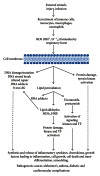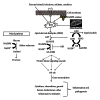Regulation of NF-κB-induced inflammatory signaling by lipid peroxidation-derived aldehydes
- PMID: 23710287
- PMCID: PMC3654319
- DOI: 10.1155/2013/690545
Regulation of NF-κB-induced inflammatory signaling by lipid peroxidation-derived aldehydes
Abstract
Oxidative stress plays a critical role in the pathophysiology of a wide range of diseases including cancer. This view has broadened significantly with the recent discoveries that reactive oxygen species initiated lipid peroxidation leads to the formation of potentially toxic lipid aldehyde species such as 4-hydroxy-trans-2-nonenal (HNE), acrolein, and malondialdehyde which activate various signaling intermediates that regulate cellular activity and dysfunction via a process called redox signaling. The lipid aldehyde species formed during synchronized enzymatic pathways result in the posttranslational modification of proteins and DNA leading to cytotoxicity and genotoxicty. Among the lipid aldehyde species, HNE has been widely accepted as a most toxic and abundant lipid aldehyde generated during lipid peroxidation. HNE and its glutathione conjugates have been shown to regulate redox-sensitive transcription factors such as NF-κB and AP-1 via signaling through various protein kinase cascades. Activation of redox-sensitive transcription factors and their nuclear localization leads to transcriptional induction of several genes responsible for cell survival, differentiation, and death. In this review, we describe the mechanisms by which the lipid aldehydes transduce activation of NF-κB signaling pathways that may help to develop therapeutic strategies for the prevention of a number of inflammatory diseases.
Figures



Similar articles
-
Mitogenic responses of vascular smooth muscle cells to lipid peroxidation-derived aldehyde 4-hydroxy-trans-2-nonenal (HNE): role of aldose reductase-catalyzed reduction of the HNE-glutathione conjugates in regulating cell growth.J Biol Chem. 2006 Jun 30;281(26):17652-60. doi: 10.1074/jbc.M600270200. Epub 2006 Apr 28. J Biol Chem. 2006. PMID: 16648138
-
High-fat diet induces changes in adipose tissue trans-4-oxo-2-nonenal and trans-4-hydroxy-2-nonenal levels in a depot-specific manner.Free Radic Biol Med. 2013 Oct;63:390-8. doi: 10.1016/j.freeradbiomed.2013.05.030. Epub 2013 May 28. Free Radic Biol Med. 2013. PMID: 23726997 Free PMC article.
-
4-Hydroxy-Trans-2-Nonenal in the Regulation of Anti-Oxidative and Pro-Inflammatory Signaling Pathways.Oxid Med Cell Longev. 2019 Nov 6;2019:5937326. doi: 10.1155/2019/5937326. eCollection 2019. Oxid Med Cell Longev. 2019. PMID: 31781341 Free PMC article. Review.
-
4-Hydroxy-2-nonenal is a powerful endogenous inhibitor of endothelial response.Biochem Biophys Res Commun. 2001 Mar 30;282(2):557-61. doi: 10.1006/bbrc.2001.4586. Biochem Biophys Res Commun. 2001. PMID: 11401496
-
Pro-apoptotic effects of lipid oxidation products: HNE at the crossroads of NF-κB pathway and anti-apoptotic Bcl-2.Free Radic Biol Med. 2017 Oct;111:209-218. doi: 10.1016/j.freeradbiomed.2016.11.010. Epub 2016 Nov 10. Free Radic Biol Med. 2017. PMID: 27840321 Review.
Cited by
-
Cardiopulmonary bypass and oxidative stress.Oxid Med Cell Longev. 2015;2015:189863. doi: 10.1155/2015/189863. Epub 2015 Feb 4. Oxid Med Cell Longev. 2015. PMID: 25722792 Free PMC article. Review.
-
New facets of nanozyme activity of ceria: lipo- and phospholipoperoxidase-like behaviour of CeO2 nanoparticles.RSC Adv. 2021 Nov 2;11(56):35351-35360. doi: 10.1039/d1ra06730c. eCollection 2021 Oct 28. RSC Adv. 2021. PMID: 35493182 Free PMC article.
-
Aldose reductase inhibitor increases doxorubicin-sensitivity of colon cancer cells and decreases cardiotoxicity.Sci Rep. 2017 Jun 9;7(1):3182. doi: 10.1038/s41598-017-03284-w. Sci Rep. 2017. PMID: 28600556 Free PMC article.
-
Oxidative and Nitrosative Stress in Age-Related Macular Degeneration: A Review of Their Role in Different Stages of Disease.Antioxidants (Basel). 2021 Apr 23;10(5):653. doi: 10.3390/antiox10050653. Antioxidants (Basel). 2021. PMID: 33922463 Free PMC article. Review.
-
Mitochondrial dysfunction and oxidative stress in aging and cancer.Oncotarget. 2016 Jul 19;7(29):44879-44905. doi: 10.18632/oncotarget.9821. Oncotarget. 2016. PMID: 27270647 Free PMC article. Review.
References
-
- Pillon NJ, Croze ML, Vella RE, Soulère L, Lagarde M, Soulage CO. The lipid peroxidation by-product 4-hydroxy-2-nonenal (4-HNE) induces insulin resistance in skeletal muscle through both carbonyl and oxidative stress. Endocrinology. 2012;153(5):2099–2111. - PubMed
-
- Kang CS, Kim HW, Kim BK, et al. Hepatotoxicity and nephrotoxicity produced by 4-hydroxy-2-nonenal (4-HNE) following 4-week oral administration to sprague-dawley rats. Journal of Toxicology and Environmental Health A. 2011;74(12):779–789. - PubMed
-
- Karihtala P, Kauppila S, Puistola U, Jukkola-Vuorinen A. Divergent behaviour of oxidative stress markers 8-hydroxydeoxyguanosine (8-OHdG) and 4-hydroxy-2-nonenal (HNE) in breast carcinogenesis. Histopathology. 2011;58(6):854–862. - PubMed
-
- Uno K, Kato K, Kusaka G, Asano N, Iijima K, Shimosegawa T. The balance between 4-hydroxynonenal and intrinsic glutathione/glutathione S-transferase A4 system may be critical for the epidermal growth factor receptor phosphorylation of human esophageal squamous cell carcinomas. Molecular Carcinogenesis. 2011;50(10):781–790. - PubMed
Publication types
MeSH terms
Substances
LinkOut - more resources
Full Text Sources
Other Literature Sources

